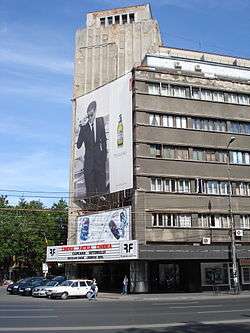Horia Creangă
Horia Creangă (20 July 1892 – 1 August 1943) was an architect and key figure of the modernist movement in Romania. Described as "the true founder of the modernist age" in his native county,[1] he is best known as the designer of the first large scale modernist building in Romania, the ARO building on Magheru Blvd., Bucharest, completed in 1931.
Horia Creangă | |
|---|---|
| Born | 20 July 1892 |
| Died | 1 August 1943 (aged 51) |
| Nationality | Romanian |
| Occupation | Architect |
| Buildings | ARO building |
Early life
Born in Bucharest on 20 July 1892, the grandson of the famous Romanian writer Ion Creangă,[2] he studied at the Bucharest School of Architecture in 1916 before attending the Ecole des Beaux Arts in Paris, graduating in 1925. His mentor Gustav Umbdenstock then secured a position for him in the Romanian Nord Railway company,[3] and in late 1926, he returned to Romania with his wife Lucia.[3]
Career

Creanga was one of the first architects in Romania to adopt the basic elements of modernist design, in designs which progressed rapidly from complex stepped forms in his first projects of the late 1920s to simple unadorned volumes, or dominant horizontal and vertical massing by 1930.
In 1929 Creangă, in collaboration with his brother, Ion, and his wife, won the competition to design the ARO building for the Asigurarea Romaneasca Insurance company, a multi-use building including shops, offices and apartments, and eventually a cinema.[3] Completed in 1931, after the design was simplified into simple bold horizontal and vertical masses, it is the first important large scale modernist building completed in Romania.[4], and established Creangă's career.
In 1935, he opened an office with architects Haralamb Georgescu and Nicolae Nedelescu, working primarily for three clients: ARO assurance, Malaxa industries, and Bucharest City Hall.[5] For these clients Creangă designed industrial, office and residential buildings,[5] notably including the Malaxa Industries factories (1930–1940), becoming one of the most respected modernists in industrial architecture.[4] The Encyclopedia of 20th Century Architecture states that "..despite the austerity of Creanga's modernist vocabulary, he reached a remarkable expressive force that remained unequaled in the production of the industrial architecture."[4]
Throughout the 1930s he designed numerous villas and small apartment buildings, as well as public buildings like the Republic Stadium Bucharest. His Malaxa Factories and the Malaxa-Burileanu Building, with bold horizontal lines, unadorned surfaces and large areas of glass, are the most clearly Bauhaus influenced buildings in Romania. His work of the later 1930s however showed an influence of the stylised classical of Italian architecture of the 1930s, such as the formal facades, with fine vertical ribs of the ARO Palace Hotel in Brasov and the Chernivtsi Cultural Palace.
His work was not uncontroversial. The ARO building which made his reputation and influenced the embrace of Modernism in Romania was fiercely criticized as well.[5] His works were not published by mainstream Romanian industrial publications until the late 1930s.[6]
His career was cut short by his death when he was only 51.
Selected projects
Drawn from the article on Horia Creanga from the Century of Romanian Architecture website [7], and Romanian Modernism 1920-1940
- Dr. Petru Groza Villa, Deva (1927-1929)
- ARO Building, 12-14 Magheru Blvd., Bucharest (1930-1931); Patria Cinema added 1934-35[8]
- Villa Ion Miclescu, 56 Paris Street, Bucharest (1930)
- Villa Thomas, 15 Iatropol str., Bucharest (1931)
- Villa Alexandru Bunescu, 12 Alexandru Aleea, Bucharest (1932)
- Anton Davidoglu apartments, Dacia Blvd. cnr Piata Spania, Bucharest (1932)
- Republic Stadium, Bucharest (with Haralamb Georgescu) (1933-1939), demolished 1988
- Elena Ottulescu apartments, 12 General Gheorghe Manu Street, Bucharest (1934-1935)
- Vila Elizabeta Cantacuzino, Aleea Alexandru nr. 15, Bucharest (1936)
- ARO Apartment Building, 91-93 Calea Victoriei, Bucharest (1936-1938)
- Malaxa (later FAUR) Factory, Auto factory, pipe factory, administration and entrance, Bucharest (1930-1939)
- Malaxa-Burileanu Building, 35 Magheru Blvd., Bucharest (1935-1937)
- Low cost housing complex, 52-58 Șoseaua Iancului, 4-24 Victor Manu Street, Bucharest (1937)
- National-Cultural Palace, Teatral'na Ploshcha (Theatre Square), Cernăuți, (now Chernivtsi, Ukraine) (1937-40).[9]
- ARO Palace Hotel, Brasov, (with Haralamb Georgescu) (1937-1939)
Gallery
 Central Market, Obor, 1936-50
Central Market, Obor, 1936-50- ARO Palace, Brasov, 1937-39
- ARO block, Bucharest, 1930-31
- ARO Apartments, Calea Victoriei, 1936-38
- Malaxa-Burileanu Building, Bucharest, 1935-37
 National-Cultural Palace, Theatre Square, Chernivtsi, Ukraine, 1937-40
National-Cultural Palace, Theatre Square, Chernivtsi, Ukraine, 1937-40
References
- Machedon, Luminiţa; Ernie Scoffham (1999). Romanian modernism: the architecture of Bucharest 1920-1940. MIT Press. p. 51. ISBN 0-262-13348-2.
- Horia Creangă - crezul simplităţii at cotidianul.ro (in Romanian)
- Machedon and Scoffham, 52.
- Sennott, Stephen (2004). Encyclopedia of 20th Century Architecture. Taylor & Francis. p. 183. ISBN 1-57958-433-0.
- Machedon and Scoffham, 53.
- Machedon and Scoffham, 57.
- "Horia Creanga". Century of Romanian Architecture. Fundatia Culturala META. Retrieved 27 April 2018.
- "The ARO Block (1929-1931) - Horia Creangă". Via Bucharesti (in Romanian). Retrieved 27 April 2018.
- Laurenţiu Dragomir, Monumente istorice și de arhitectură din ținutul Cernăuților, p.59
| Wikimedia Commons has media related to Horia Creangă. |